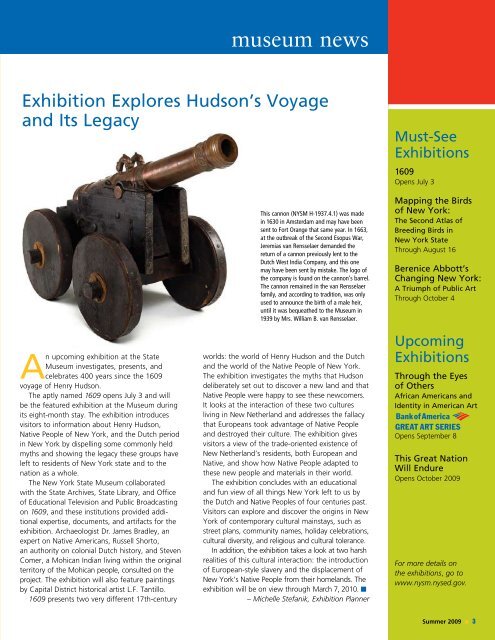Distinctly Dutch - New York State Museum
Distinctly Dutch - New York State Museum
Distinctly Dutch - New York State Museum
Create successful ePaper yourself
Turn your PDF publications into a flip-book with our unique Google optimized e-Paper software.
museum news<br />
Exhibition Explores Hudson’s Voyage<br />
and Its Legacy<br />
This cannon (NYSM H-1937.4.1) was made<br />
in 1630 in Amsterdam and may have been<br />
sent to Fort Orange that same year. In 1663,<br />
at the outbreak of the Second Esopus War,<br />
Jeremias van Rensselaer demanded the<br />
return of a cannon previously lent to the<br />
<strong>Dutch</strong> West India Company, and this one<br />
may have been sent by mistake. The logo of<br />
the company is found on the cannon’s barrel.<br />
The cannon remained in the van Rensselaer<br />
family, and according to tradition, was only<br />
used to announce the birth of a male heir,<br />
until it was bequeathed to the <strong>Museum</strong> in<br />
1939 by Mrs. William B. van Rensselaer.<br />
Must-See<br />
Exhibitions<br />
1609<br />
Opens July 3<br />
Mapping the Birds<br />
of <strong>New</strong> <strong>York</strong>:<br />
The Second Atlas of<br />
Breeding Birds in<br />
<strong>New</strong> <strong>York</strong> <strong>State</strong><br />
Through August 16<br />
Berenice Abbott’s<br />
Changing <strong>New</strong> <strong>York</strong>:<br />
A Triumph of Public Art<br />
Through October 4<br />
An upcoming exhibition at the <strong>State</strong><br />
<strong>Museum</strong> investigates, presents, and<br />
celebrates 400 years since the 1609<br />
voyage of Henry Hudson.<br />
The aptly named 1609 opens July 3 and will<br />
be the featured exhibition at the <strong>Museum</strong> during<br />
its eight-month stay. The exhibition introduces<br />
visitors to information about Henry Hudson,<br />
Native People of <strong>New</strong> <strong>York</strong>, and the <strong>Dutch</strong> period<br />
in <strong>New</strong> <strong>York</strong> by dispelling some commonly held<br />
myths and showing the legacy these groups have<br />
left to residents of <strong>New</strong> <strong>York</strong> state and to the<br />
nation as a whole.<br />
The <strong>New</strong> <strong>York</strong> <strong>State</strong> <strong>Museum</strong> collaborated<br />
with the <strong>State</strong> Archives, <strong>State</strong> Library, and Office<br />
of Educational Television and Public Broadcasting<br />
on 1609, and these institutions provided additional<br />
expertise, documents, and artifacts for the<br />
exhibition. Archaeologist Dr. James Bradley, an<br />
expert on Native Americans, Russell Shorto,<br />
an authority on colonial <strong>Dutch</strong> history, and Steven<br />
Comer, a Mohican Indian living within the original<br />
territory of the Mohican people, consulted on the<br />
project. The exhibition will also feature paintings<br />
by Capital District historical artist L.F. Tantillo.<br />
1609 presents two very different 17th-century<br />
worlds: the world of Henry Hudson and the <strong>Dutch</strong><br />
and the world of the Native People of <strong>New</strong> <strong>York</strong>.<br />
The exhibition investigates the myths that Hudson<br />
deliberately set out to discover a new land and that<br />
Native People were happy to see these newcomers.<br />
It looks at the interaction of these two cultures<br />
living in <strong>New</strong> Netherland and addresses the fallacy<br />
that Europeans took advantage of Native People<br />
and destroyed their culture. The exhibition gives<br />
visitors a view of the trade-oriented existence of<br />
<strong>New</strong> Netherland’s residents, both European and<br />
Native, and show how Native People adapted to<br />
these new people and materials in their world.<br />
The exhibition concludes with an educational<br />
and fun view of all things <strong>New</strong> <strong>York</strong> left to us by<br />
the <strong>Dutch</strong> and Native Peoples of four centuries past.<br />
Visitors can explore and discover the origins in <strong>New</strong><br />
<strong>York</strong> of contemporary cultural mainstays, such as<br />
street plans, community names, holiday celebrations,<br />
cultural diversity, and religious and cultural tolerance.<br />
In addition, the exhibition takes a look at two harsh<br />
realities of this cultural interaction: the introduction<br />
of European-style slavery and the displacement of<br />
<strong>New</strong> <strong>York</strong>’s Native People from their homelands. The<br />
exhibition will be on view through March 7, 2010. n<br />
– Michelle Stefanik, Exhibition Planner<br />
Upcoming<br />
Exhibitions<br />
Through the Eyes<br />
of Others<br />
African Americans and<br />
Identity in American Art<br />
Opens September 8<br />
This Great Nation<br />
Will Endure<br />
Opens October 2009<br />
For more details on<br />
the exhibitions, go to<br />
www.nysm.nysed.gov.<br />
Summer 2009 n 3
















